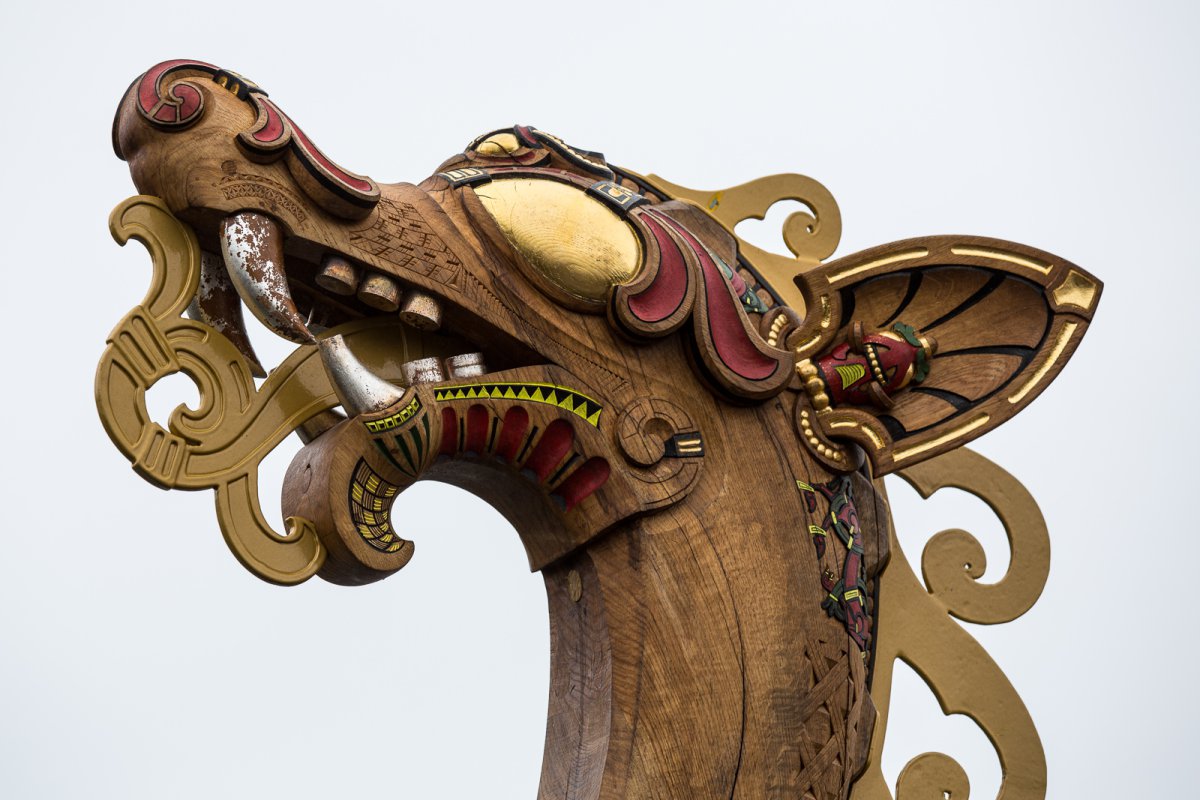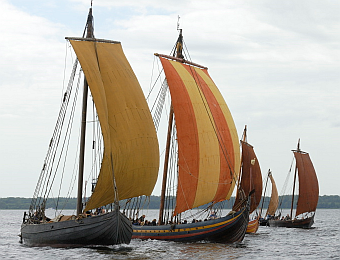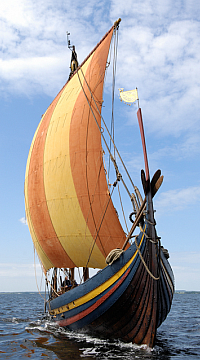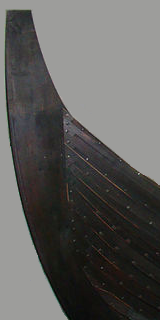|
Parts of the following text are quoted from
http://en.wikipedia.org/wiki/Viking_Age and from
http://en.wikipedia.org/wiki/Viking_ship
Viking Navigators
Late in the 9th century Norse Vikings explored the north atlantic, resulting in the
foundation of independent settlements in the Shetland, Orkney, and Faroe Islands
and later on Iceland and Greenland.
After Erik the Red had explored and settled in Greenland in 986, an expedition under his sun
Leif Ericson, reached North America around 1000 and set up short-lived settlements in
present-day L'Anse aux Meadows, Newfoundland, and Labrador, Canada.
This was about fivehundert years before Columbus re-discovered the american continent.
For the next couple of centuries, an intense north atlantic trading trafic developed between Norway and the colonies in Iceland and Greenland during which Norse Viking developed great maritime skills allowing them to navigate through stormy and foggy seas. But by about 1500 the settlements in Greenland were abandoned and the Norse Greenlanders and their explorations of the New World receded into the realms of myth. Technology
The Vikings were equipped with the technologically superior longships; for purposes
of conducting trade however, another type of ship, the knarr, wider and deeper in
draft, were customarily used.
The Vikings were competent sailors, adept in land warfare as well as at sea, and
they often struck at accessible and poorly defended targets, usually with near impunity.
The effectiveness of these tactics earned Vikings a formidable reputation as raiders
and pirates.
Chroniclers paid little attention to other aspects of medieval Scandinavian culture. This slant was accentuated by the absence of contemporary primary source documentation from within the Viking Age communities themselves. Little documentary evidence was available until later, when Christian sources began to contribute. As historians and archaeologists have developed more resources to challenge the one-sided descriptions of the chroniclers, a more balanced picture of the Norsemen has become apparent.
When the ships were sufficiently close, melee combat would ensue using axes, swords,
and spears until the enemy ship could be easily boarded.
The roping technique allowed Viking crews to remain strong in numbers and act as a unit,
but this uniformity also created problems.
A Viking ship in the line could not retreat or pursue hostiles without breaking the
formation and cutting the ropes, which weakened the overall Viking fleet and was a
burdensome task to perform in the heat of battle.
In general, these tactics enabled Vikings to quickly destroy the meagre opposition
posted during raids.
Together with an increasing centralization of government in the Scandinavian countries, the old system of leidang - a fleet mobilization system, where every skipen (ship community) had to deliver one ship and crew - was discontinued. Changes in shipbuilding in the rest of Europe led to the demise of the longship for military purposes. By the 11th and 12th centuries, European fighting ships were built with raised platforms fore and aft, from which archers could shoot down into the relatively low longships. The nautical achievements of the Vikings were exceptional. For instance, they made distance tables for sea voyages that were remarkably precise. They have been found to differ only 2-4% from modern satellite measurements, even on such long distances as across the Atlantic Ocean. The archaeological find known as the Visby lenses from the Swedish island of Gotland may be components of a telescope. It appears to date from long before the invention of the telescope in the 17th century. Recent evidence suggests that the Vikings also made use of an optical compass as a navigation aid, using the light-splitting and polarization-filtering properties of Iceland spar to find the location of the sun when it was not directly visible. Viking ships
Propulsion
The longships had two methods of propulsion: oars and sail. At sea, the sail enabled
longships to travel faster than by oar and to cover long distances overseas.
Sails could be raised or lowered quickly.
Oars were used when near the coast or in a river, to gain speed quickly, and when
there was an adverse (or insufficient) wind.
In combat, the variability of wind power made rowing the chief means of propulsion.
Longships were not fitted with benches. When rowing, the crew sat on sea chests (chests containing their personal possessions) that would otherwise take up space. The chests were made the same size and were the perfect height for a Viking to sit on and row. Longships had hooks for oars to fit into, but smaller oars were also used, with crooks or bends to be used as oarlocks. If there were no holes then a loop of rope kept the oars in place. An innovation that improved the sail's performance was the beitass, or stretching pole - a wooden spar stiffening the sail. Construction
Navigation
With such vast technological improvements, the Vikings began making increasingly more
ocean voyages, as their ships were infinitely more sea worthy.
In order to sail in ocean waters, the Vikings needed to develop methods of relatively
precise navigation.
 Most commonly, a ship was piloted using ancestral knowledge.
Essentially, the Vikings simply used prior familiarity with tides, sailing times,
and landmarks in order to route courses.
In fact, scholars contend that the mere position of a whale allowed the Vikings to
determine their direction.
Whales feed in highly nutritious waters, commonly found in regions where landmasses
have pushed deep-water currents towards shallower areas.
The sighting of a whale consequently functioned as a signal land was near.
Most commonly, a ship was piloted using ancestral knowledge.
Essentially, the Vikings simply used prior familiarity with tides, sailing times,
and landmarks in order to route courses.
In fact, scholars contend that the mere position of a whale allowed the Vikings to
determine their direction.
Whales feed in highly nutritious waters, commonly found in regions where landmasses
have pushed deep-water currents towards shallower areas.
The sighting of a whale consequently functioned as a signal land was near.
However, some academics also argue that the Vikings developed more tangible means
of navigation.
Many claim the Vikings used a sun compass to show their direction.
This compass comprises a vertical pointer on a horizontal surface, on which the shadow
of the pointer, the so-called gnomon, is drawn through the day.
The shadow curve is different at different latitudes and at different times of the year,
so in order to use it for navigation, a series of curves is necessary.
A wooden half-disc found on the shores of Narsarsuaq, Greenland seems to initially
lend credibility to this belief.
However, researchers found that the slits circumnavigating the disc are
disproportionately spaced, casting severe doubts about its role as an
accurate compass.
Many now hold that the instrument is a "confession disc", used by priests to count
the number of confessions in their parish.
 In a similar sense, researchers and historians continually debate the use of sunstone
in Viking navigation.
Recent studies identify the sunstone, with its ability to polarize light, as a plausible
method for determining direction.
The sunstone effectively has the potential to show the positioning of the sun, even if
obscured by clouds, by showing which direction light waves are oscillating.
The stone will become a certain colour based on the direction of the waves, but the process
is only possible if the object is held in an area with direct sunlight.
Thus, most scholars debate the reliability and the plausibility of using a navigational
tool that can only determine direction in such limited conditions.
In a similar sense, researchers and historians continually debate the use of sunstone
in Viking navigation.
Recent studies identify the sunstone, with its ability to polarize light, as a plausible
method for determining direction.
The sunstone effectively has the potential to show the positioning of the sun, even if
obscured by clouds, by showing which direction light waves are oscillating.
The stone will become a certain colour based on the direction of the waves, but the process
is only possible if the object is held in an area with direct sunlight.
Thus, most scholars debate the reliability and the plausibility of using a navigational
tool that can only determine direction in such limited conditions.Viking sagas routinely tells of voyages where Vikings suffer from being "hafvilla" (bewildered): voyages beset by fog or bad weather where they completely lost their sense of direction. This description suggests they did not use a sunstone to aid them when the sun was obscured. Also, they would experience hafvilla when the wind died, implying they relied on prevailing winds to navigate, further supporting the use of ancestral knowledge for piloting. Sources
1.
http://en.wikipedia.org/wiki/Viking_Age
2. http://en.wikipedia.org/wiki/Viking_ship 3. "The Last Vikings: The Epic Story of the Great Norse Voyagers", Kirsten A. Seaver, 2010, I.B. Tauris & Co Ltd., London - New York | ||||||||||
| Cover << Sail Away << Discoverers and Navigators << . | last updated: 26-Feb-2012 |


 The long-ship is characterized as a graceful, long, narrow, light, wooden boat
with a shallow draft hull designed for speed. The ship's shallow draft allowed
navigation in waters only one metre deep and permitted beach landings, while
its light weight enabled it to be carried over portages. Longships were also
double-ended, the symmetrical bow and stern allowing the ship to reverse direction
quickly without having to turn around; this trait proved particularly useful in
northern latitudes where icebergs and sea ice posed hazards to navigation.
Longships were fitted with oars along almost the entire length of the boat itself.
Later versions sported a rectangular sail on a single mast which was used to
replace or augment the effort of the rowers, particularly during long journeys.
The long-ship is characterized as a graceful, long, narrow, light, wooden boat
with a shallow draft hull designed for speed. The ship's shallow draft allowed
navigation in waters only one metre deep and permitted beach landings, while
its light weight enabled it to be carried over portages. Longships were also
double-ended, the symmetrical bow and stern allowing the ship to reverse direction
quickly without having to turn around; this trait proved particularly useful in
northern latitudes where icebergs and sea ice posed hazards to navigation.
Longships were fitted with oars along almost the entire length of the boat itself.
Later versions sported a rectangular sail on a single mast which was used to
replace or augment the effort of the rowers, particularly during long journeys.
